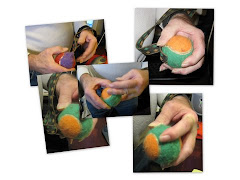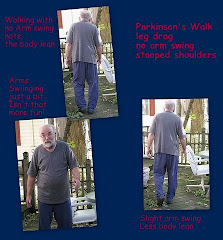Exciting the Neurons - a potential noninvasive treatment for PD
Will Transcranial Magnetic Stimulation (TMS) using pulsating low electrical currents be a future treatment of PD motor impairment symptoms? Will it hold the line or slightly reduce symptoms?
Essentially TMS causes a group of neurons in the brain to depolarize and discharge an action potential. We're already familiar with that from what we know about Spinal Cord Stimulation. "rTMS can increase or decrease the excitability of corticalspinal or corticocortical pathways depending on the intensity of stimulation, coil orientation and frequency of stimulation." There are two types of TMS: rTMS, repetitive transcranial stimulation and tDCS which is transcranial direct current stimulation.
TMS hardware varies but the basics are coils of varying shapes of plastic encasing wires with either a magnetically inert inner layer or a ferromagneticlly active solid core. The shape varience my result in changes in the focus, shape and depth of the magnetic field cortical penetration. There are several designs to move the electrical current across the scalp and skull. The most discomfort has been some pain from the scalp and related muscles or a loud audio click caused by the TMS pulse.
The patient sits in a chair similar to a dental chair but without anethesia while the coils are placed. In the case of the TMS device which received FDA approval for use in treating non-medication responsive depression, the coils are located to stimulate the area of the brain responsible for mood regulation. In treating depression the short MRI strength magnetic pulses continue for about 40 minutes. The patient returns over the next month and a half for at least 20 to 30 sessions. At the end of each session, the patient can return to routine activity.
It is felt that for Parkinson's disease motor function 15-20 sessions will have a positive effect for six to eight months. Aften that time fewer sessions will be needed to sustain the effects. The sessions are always carried out by a team which includes a Biological Psychologist and an rTMS Specialist.
The whys of how it can work for PD are still unclear but it does seem to have an effect on the presynaptic inhibition of the motor cortex. TMS appears to help balance neural network activity and to stimulate dopamine release.
There aren't many diseases where the patient would simply want to stop the progression or simply eliminate just a few symptoms but Parkinson's disease happens to be one of these diseases because until a cure is found, that is the option.
Transcranial Magnetic Stimulation is a noninvasive brain stimulation to treat Parkinson's disease symptoms and dystonia. There are several studies in underway.
What have the researchers been studying for the last few years?
Sleep disorders: which may be may be partially reversed without affecting mood or motor symptoms.
Dyskinesia: slight reduction of symptoms with no negative effects upon motor function using low frequency rTMS.
Motor function: significant improvement in UPDRS with stimulation of the motor cortex resulting in increased dopamine in the striatum which was maintained for three days following the rTMS.
Depression: improved scores were observed at three days and three weeks after treatment. An improvement was also seen in anxiety scores and movement.
Some stimulating reading:Beneficial effect of transcranial magnetic stimulation on sleep in Parkinson's disease 2/17/09
http://www.ncbi.nlm.nih.gov/pubmed/19224604
KD van Dijk, EI Most, EJ Van Someren, HW Berendse, YD van der Werk, Dept of Neurology Medical Center, Amsterdam, The Netherlands
Repetitive transcranial magnetic stimulation for levadopa induced dyskinesias in Parkinson's disease 1/30/09
http://www.ncbi.nlm.nih.gov/pubmed/18951540
SR Filipovic, JC Rothwell, BP van de Warenburg, K Bhatia
Dopamine levels after repetitive transcranial magnetic stimulation Dept of Neurology: Assiut University Hospital, Assuit, Egypt
Sobell Research Dept of Motor Neuroscience and Movement disorders, National Hospital for Neurology and Neurosurgery, Queen Square, London - 2007
http://cat.inist.fr/?aModele=afficheN&cpsidt=18817071
More Abstracts on topic:
http://www.ncbi.nlm.nih.gov/pubmed/19255412?dopt=Abstract
http://www.ncbi.nlm.nih.gov/pubmed/19255412?dopt=Abstract
http://74.125.93.104/search?q=cache:51PhTWpmWsUJ:www.bioportfolio.com/indepth/Transcranial_Magnetic_Stimulation.pdf+magnetic+stimulation+parkinson%27s+disease&cd=16&hl=en&ct=clnk&gl=us Link to trancranial magnetic stimulation info
http://www.ncbi.nlm.nih.gov/pubmed/15464863?ordinalpos=2&itool=EntrezSystem2.PEntrez.Pubmed.Pubmed_ResultsPanel.Pubmed_RVDocSum
Patent Applications:
http://patft.uspto.gov/netacgi/nph-Parser?Sect2=PTO1&Sect2=HITOFF&p=1&u=%2Fnetahtml%2FPTO%2Fsearch-bool.html&r=1&f=G&l=50&d=PALL&RefSrch=yes&Query=PN%2F7236830 2002 Patent info on systems and methods for enhancing or optimizing neural stimulation therapy for treating symptoms of Parkinson's disease and/or other movement disorders
http://patft.uspto.gov/netacgi/nph-Parser?Sect2=PTO1&Sect2=HITOFF&p=1&u=%2Fnetahtml%2FPTO%2Fsearch-bool.html&r=1&f=G&l=50&d=PALL&RefSrch=yes&Query=PN%2F7277758 2004 Patent info
http://patft.uspto.gov/netacgi/nph-Parser?Sect2=PTO1&Sect2=HITOFF&p=1&u=%2Fnetahtml%2FPTO%2Fsearch-bool.html&r=1&f=G&l=50&d=PALL&RefSrch=yes&Query=PN%2F7437196 2006 Systems and methods for selecting stimulation sites and applying treatment, including treatment of symptoms of Parkinson's disease, other movement disorders, and/or drug side effects
Patent info: North Neuroscience, Inc
Clinical Trials of Transcranial Magnetic Stimulation:
TMS intermittent theta-burst (ITBS) Transcranial Magnetic Stimulation to treat Parkinson's Disease.Accepted age range: 40-80 years
Accepted gender: male and female with Dopa responsive PD
Trial location: appears to be Rockville, MD only
http://clinicaltrials.gov/ct2/show/NCT00753519?term=NCT00753519&rank=1
Contact: Patient Recruitment and Public Liason Office (800)411-1122 National Institute of Health in Rockville, MD identifier #NCT00753519 email contact
Study on the Effect of External Magnetic Stimulation on Patients with Parkinson's Disease
Accepted age range: 40-80 years
Accepted gender: male and female
Therapeutic restrictions: none seen
For more information about study #1EA-0000071
Government identifier: NCT00841464
http://clinicaltrials.gov/ct2/show/NCT00841464
Contact: Eileen Hummel or Cassandra Brasile
Transcranial Magnetic Stimulation to Treat Parkinson's Disease
http://clinicaltrials.gov/ct2/show/NCT00753519
http://clinicaltrials.gov/ct2/results?term=transcranial+magnetic+stimulation+Parkinson%27s+disease&recr=Open
FYI: Other PD Clinical Trials
To view all Parkinson's Clinical Trials:
http://www.pdtrials.org/en/browse/all
To view Parkinson's Clinical Trials by location:
http://www.pdtrials.org/en/browse/location
To view Parkinson's clinical trials by symptomCan be movement or non-movement or both:
http://www.pdtrials.org/en/browse/location
Subscribe to:
Post Comments (Atom)














No comments:
Post a Comment
Welcome to Parkinsons Focus Today.
We are delighted to hear from you by comment here
or through email as found in Contact Us.
Please do not include email addresses if leaving a comment online.
Email addresses are used only for email responses.
Spammers take note: your messages will not be published. The comments section is for an exchange of ideas, not for backlinks.